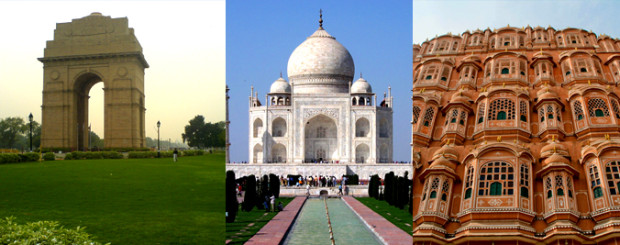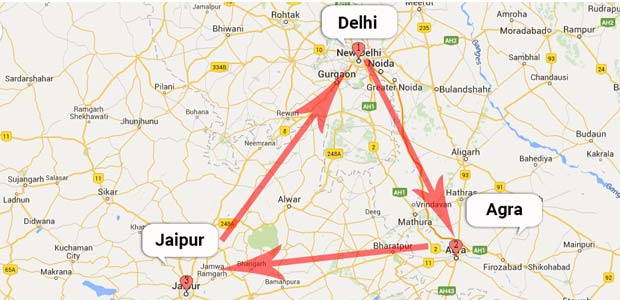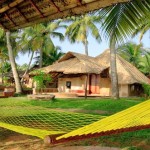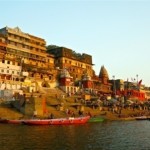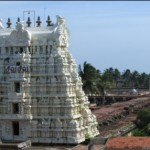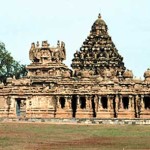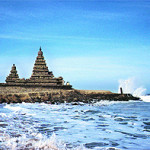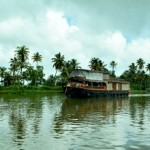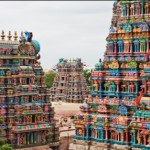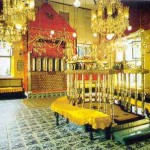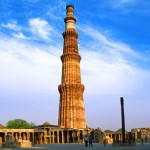11 Days Golden Triangle of India
with extension of Kashmir $ 1600
| Cities | No. Of Nights | Sightseeing & Attractions |
|---|---|---|
| Delhi | 4 | Qutab Minar | Jama Masjid | Red Fort | Rajghat | India gate | Gandhi Memorial | Rashtrapati Bhawan | Humayun’s Tomb | Rikshaw ride in Old Delhi |
| Agra | 2 | Taj Mahal | Fatehpur Sikri |
| Jaipur | 3 | City Palace | Hawa Mahal | Amber Fort | Elephant ride | Abhaneri village| Jantar Mantar |
| Inclusions: | Exclusions: |
|---|---|
|
|
Day1 : Welcome On Arrival
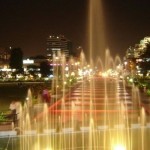
Traditional welcome on arrival at Delhi (India) airport by Visit India Trip and transferred to hotel for overnight stay. Delhi is the capital of the modern India, though it is made up of seven ancient cities, spanning over a period from 11th to 20th centuries. India is a land of wonders, love and ancient temple cities, where love letters are written on stone. Once you are touched by the magic of India, it’s hard to stop. India is a country steeped in history, diverse in landscape and abundant in just about every form of culture. India is beautiful, grand, fascinating and so full of life, energy and color that you can never visit it just once.”
Day2 :Historic City of Delhi
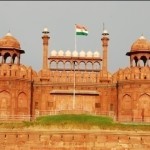
Today, we go for full day a guided tour of the historic city of Delhi. The city where one can experience the influence of the many rulers who ruled this region, a city built and destroyed and re-built over seven times. We visit following places.
Jama Masjid – one of the Asia’s largest mosque, cycle rickshaw ride through the narrow lanes of Old Delhi passing through Chandni Chowk, Chawri Bazaar etc, Humanyun’s Tomb, Qutab Minar – the 73m tall minaret, India Gate war memorial, President’s House and drive through Connaught Place.
India Gate: The India Gate is situated in the heart of New Delhi. The India Gate was designed by Sir Edwin Lutyens. Built in 1931, it commemorates the 90,000 soldiers of the Indian Army who lost their lives while fighting for the Indian Empire, or more correctly the British Raj, in World War I and the Third Anglo-Afghan War. (Meals: Breakfast, Lunch, and Dinner)
Day3 : Explore Delhi City
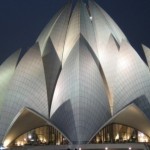
This is second day to explore Delhi city. After breakfast we visit places like:
Gandi Memorial: The former residence of Indira Gandhi is now a museum, displaying photos and newspaper clippings, as well as personal belongings. One can also see the collection of the personal moments of the Nehru-Gandhi family.
Rajghat: Raj Ghat is a memorial to Mahatma Gandhi, which was originally the name of a historic ghat of Old Delhi on the banks of river Yamuna. The memorial was designed by Vanu G. Bhuta, reflecting the simplicity of Mahatma Gandhi’s life. The design had the black marble slab surrounded by red earth.
Qutub Minar: Qutub Minar, today, a UNESCO World Heritage Site in Delhi was constructed with red sandstone and marble. It is the tallest minaret in India with a height of 72.5 metres (237.8 ft). The Construction was commenced by qutub-ud-din Aibak in 1192, but completed by Iltutmish.
Gold domed Sikh Temple – is the most prominent Gurudwara in Delhi and is associated with the eighth Sikh Guru, Guru Har Krishan. It was first built as a small temple by Sikh General Sardar Bhagel Singh in 1783, who supervised the construction of nine Sikh shrines in Delhi during the reign of Mughal Emperor Shah Alam. As with all Sikh Gurudwaras, the concept of langar (community meal) is practiced here and anyone may eat in the Gurudwaras Kitchen.
Highlight of the Tour: The Highlight of the tour is the Rickshaw ride in Old Delhi. We will pass through the Chandni Chowk by the Rickshaw. The rickshaw pullers here take you on a ride through various routes. The Rikshaw ride gives you a chance to glance at the colorful street of the place. Chandni Chowk is very colorful & you will find the hustle and bustle market.
(Meals: Breakfast, Lunch, and Dinner )
Day4: Arrival at Agra
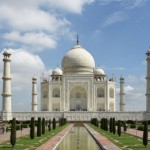
After breakfast we proceed Agra by road. The Taj Mahal, an essential sight for all visitors to India is one of the most achingly beautiful architectural achievements in the world, and is considered to be a symbol of enduring love. Shrouded in white marble the sheer elegance, purity and sentiment that are an integral part of the monument have touched the hearts of people from all corners of the world. One of the Seven Wonders of the World and a world heritage site was built by Mughal Emperor Shah Jahan in loving memory of his beloved wife Mumtaz Mahal who died while giving birth to their fourteenth child. Built in pure white marble Taj Mahal is located along the banks of the River Yamuna, the Taj spreads across almost 42 acres of land and it is believed that this particular spot was chosen by the emperor because of its peaceful and soothing effect. One of the seven wonders of the world, it stands as a tribute to undying love and all who visit it stand awed at the first impression created by this marvel in white marble. Upon your arrival at Agra you will check in to your hotel. Evening, we will visit the Moonlight Garden also known as Mehtab Bagh. The places are situated on the opposite side of the Yamuna River. The Garden was built by the Emperor Babur. This is the best place to visit the Taj Mahal across the Yamuna River. (Meals: Breakfast, Lunch, and Dinner at the hotel).
Day5 : Taj Mahal at Sunrise

Morning we will visit the Taj Mahal at sunrise. Taj Mahal is UNESCO World Heritage Site and one of the New Seven Wonders of the World, Taj Mahal enthralls visitors with its shimmering beauty. Today your guide will pick you up from your hotel for a private tour of Taj Mahal, the most beautiful monument built by the Mughals, the Muslim rulers of India. TAJ MAHAL- Described as the most extravagant monument ever built for love. What makes the Taj unique is its perfect proportions, distinct femininity, medium of construction and ornamentation. Its marble exterior reflects rose and golden tints at sunrise and sunset, while it is dazzling white during the day and glows like a pearl in the moonlight and during the monsoon.
Agra Fort – lies on the bend of the river Yamuna, almost in the heart of the town. Akbar built it as his citadel over the years 1563-73 in the finest architectural style. It has imposing gates and walls of red sandstone and a moat.
Itmad-ul-Daula, Situated 4 km North of the Taj, on the left bank of the Yamuna, is the perfectly proportioned marble mausoleum Itmad-ud-Daulah. Noor Jehan constructed this splendid marble monument in her father’s memory. This double storied marble tomb is replete with mosaic, inlaid with semi-precious stones. (Meals: Breakfast, Lunch, and Dinner)
Day6 : City of Jaipur
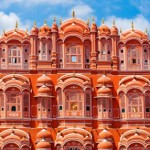
This morning after breakfast you will drive to the pink city of Jaipur, enroute you will visit the Fatehpur Sikri, the deserted red sandstone city built by the Mughal Emperor Akbar. On arrival check into your hotel and rest of the day is at leisure.
In terms of architecture and layout, the city has a rectangular shape. All the designing was carried out as per instructions laid down in the ancient indian treatise on architecture called the ‘Shilpa Shastras’. Exceptionally well-planned, Jaipur has broad roads and wide lanes that offset the uniform rows of the city’s shops in the main marketplace. The most important monuments in Jaipur proper are concentrated in the historical Palace area that is central to the city and is called the Chokri Sarhad. Over time it was seen that the setting sun cast a pink glow on the walls and tenements of the city’s structures and it came to acquire the name ‘Pink City’. On the way we stop at the small ancient village of Abhaneri in northern Rajasthan. Begin at Chand Baori, one of the largest step wells in India, fortified on all sides. This unique idea was conceived by the early natives to work as a water reservoir, located adjacent to the temple dedicated to Harshat Mata, goddess of joy and happiness – an architectural jewel.
(Meals: Breakfast, Lunch, and Dinner)
Day7 :Private Tour of Jaipur
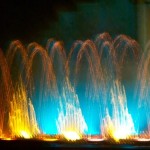
Today your guide will pick you up from your hotel for a private tour of Jaipur. The Pink City of Jaipur is a charming place, which dazzles the eye of a tourist with several architectural landmarks, stylish monuments, palaces, museums, wide avenues and colorful bazaars. Though less than 300 years old, the city is already full of mysteries and legends. Jaipur is surrounded by hilltop forts such as Amber Fort, Jaigarh and Nahargarh. Enjoy your wonderful discovery of the unparalleled beauty of Jaipur.
Amber Fort – Proceed for a morning excursion to Amber Fort. Elephant ride ascent to the fort. Perched on a hill some 11km from Jaipur, and nestling among the Aravalli Hills, is the historic fort-palace of Amber. Set in a picturesque background, the splendid Amber Fort (Jaigarh) was built in 1600 by Raja Man Singh, commander-in-chief of the Mughal army during Akbar’s reign and certainly one the greatest general of medieval India. The fort also made the headlines after Independence when it was supposed to be the most likely hiding place of the Kuchwahas’ famous lost treasure.
City Palace-Conceived and designed by Jai Singh, the City palace is a fine blend of Rajasthani and Mughal architecture. One of the most important architectural landmarks in Jaipur, this he palace complex has numerous buildings, courtyards, impressive gateways and temples. The palace houses Sawai Jai Singh’s seven-storey facade Chandra Mahal (“moon palace”), solid marble Mubarak Mahal, the Diwan-e-Aam and Diwan-e-Khas (the Hall of Private Audience). Chandra Mahal is still the residence of the present royal family.
Hawa Mahal- Arguably Jaipur’s most acclaimed landmark, the tapering Hawa Mahal, or “Palace of Winds” was built in 1799 to enable the ladies of the royal household to watch street processions while remaining in a strict state of purdah. Its five-storey facade, decked with no less than 593 finely screened windows and balconies, makes the building seem far larger than it really is; in fact it is little more than one room thick in most parts.
(Meals: Breakfast, Lunch, and Dinner the hotel)
Day8 : Visit of Aravalli Hills, Jaigarh, Mubarak Mahal
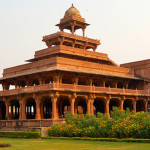
Today your guide will pick you up from your hotel for a private tour of Jaipur. The Pink City of Jaipur is a charming place, which dazzles the eye of a tourist with several architectural landmarks, stylish monuments, palaces, museums, wide avenues and colorful bazaars. Though less than 300 years old, the city is already full of mysteries and legends. Jaipur is surrounded by hilltop forts such as Amber Fort, Jaigarh and Nahargarh. Enjoy your wonderful discovery of the unparalleled beauty of Jaipur.
Amber Fort – Proceed for a morning excursion to Amber Fort. Elephant ride ascent to the fort. Perched on a hill some 11km from Jaipur, and nestling among the Aravalli Hills, is the historic fort-palace of Amber. Set in a picturesque background, the splendid Amber Fort (Jaigarh) was built in 1600 by Raja Man Singh, commander-in-chief of the Mughal army during Akbar’s reign and certainly one the greatest general of medieval India. The fort also made the headlines after Independence when it was supposed to be the most likely hiding place of the Kuchwahas’ famous lost treasure.
City Palace-Conceived and designed by Jai Singh, the City palace is a fine blend of Rajasthani and Mughal architecture. One of the most important architectural landmarks in Jaipur, this he palace complex has numerous buildings, courtyards, impressive gateways and temples. The palace houses Sawai Jai Singh’s seven-storey facade Chandra Mahal (“moon palace”), solid marble Mubarak Mahal, the Diwan-e-Aam and Diwan-e-Khas (the Hall of Private Audience). Chandra Mahal is still the residence of the present royal family.
Hawa Mahal- Arguably Jaipur’s most acclaimed landmark, the tapering Hawa Mahal, or “Palace of Winds” was built in 1799 to enable the ladies of the royal household to watch street processions while remaining in a strict state of purdah. Its five-storey facade, decked with no less than 593 finely screened windows and balconies, makes the building seem far larger than it really is; in fact it is little more than one room thick in most parts.
(Meals: Breakfast, Lunch, and Dinner the hotel)
Day9 :Go For Shopping
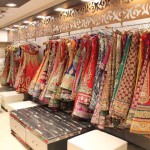
After breakfast go for shopping. The Jaipur rivals Delhi and Mumbai when it comes to shopping, and there are plenty of bazaars selling almost anything you could want. For glitzy jewelry, sparkling gemstones or Jaipuri quilts, hit the stalls of Johari Bazaar in the Old City. For ready-made textiles and Rajasthani camel-leather shoes (jootis), try Bapu Bazaar, or for souvineers and gifts for friends back home, like resin bangles, head to Tripolia Bazaar.Jantar Mantar: Walk to the adjacent Jantar Mantar (Astronomical Observatory), a collection of architectural astronomical instruments, built by Maharaja Jai Singh II at his then new capital of Jaipur between 1727 and 1733. The observatory instruments are in most cases huge structures, built on such scale so that accuracy of readings can be obtained. The samrat yantra, for instance, which is a sundial, can be used to tell the time to an accuracy of about a minute. Enjoy the remainder of the day to wander about the local markets where you will find lovely silver jewelry, handicrafts and roadside mehndiwala (henna painters) who will paint ladies hands in the local tradition.
In the evening, take a romantic boat ride to the mysterious Jal Mahal (Water Palace), a five-story sandstone palace partially submerged in the middle of a lake. Stroll the rooftop gardens as the sun sets over the lake.
Day10 :Delhi By Road

Today we transfer to Delhi by road. Upon arrival, time to freshen up before tonight’s festivities.
In the evening spend time for shopping. Bid farewell to your new-found friends and Tour Manager at a festive Farewell Dinner at the hotel.
Day11 : Flight back to USA

Transfer to the airport for your departure flight. Take International Flight back to USA.
(Meals: Breakfast)
EXTENTION 8 DAYS LADAKH AND KASHMIR
| Cities | No. Of Nights | Sightseeing & Attractions |
|---|---|---|
| Ladakh | 4 | Silk Route | Samker & Leh Bazaar | Leh Temple | Excursion to Phyang & Spituk | Spituk monastery | Excursion to Sankar Gompa & Shanti Stupa | Enjoy the famous blue brackish Lake of Pangong | Day excursion to Khardongla pass- highest motorable pass in the world 5600 Mtrs |
| Kashmir | 3 | Srinagar | full day excursion to Sonmarg | full day excursion to Gulmarg |
Day 1 : Delhi – Leh by flight (Flight duration 1 hour 30 minutes)
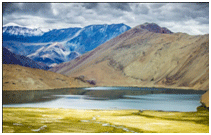
Upon arrival at Leh Airport you will met by our representative and Welcome in traditional Ladakhi style and transfer to hotel, rest of the day at leisure to acclimatize. Overnight stay at hotel.
Leh City: The capital of Ladakh, at one time was a major stop on the Asian “Silk Route”. A stroll along the main bazar, observing the varied crowd and peering into the curio shops, is an entrancing experience. Chang Gali, behind the main bazar is less bustling but has intriguing little shops selling curios and jewelry like pearls, turquoise, coral, malachite, lapis and many other kinds of semi-precious stones, as well as curiously carved Yak- horn boxes, quaint brass locks, china or metal bowls etc. Later in the evening walk upto Samker & Leh Bazaar. Samker Gompa-little up in the valley, 3 Kms from Leh Town,which is open to visitors in the morning and evening only. The Gompa 18th Century,is the seat of the Head Lama of Ladakh & founder of yellow sect, Tson-Kha-Pa. After Samker, visit Leh Temple & Walk back to Leh Bazaar through the famous Leh Polo Ground. (Meals: Breakfast, Lunch, Dinner)
Day 2: Leh: AM: Excursion to Phyang & Spituk PM: Excursion to Sankar Gompa & Shanti Stupa :
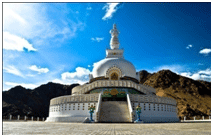
After breakfast proceed to Phyang, Located 22 Kms from Leh. The monastery is remarkably built on the hilltop, similar to the Likir monastery. This monastery belongs to the Degungpa order. On the way back visit to Spituk monastery which was founded by Od Lde, in the 11th century AD. Later we drive back to hotel on time for lunch. Later in the afternoon, guided sightseeing tour visiting the Sanker Gompa, which is towards the north of the Town, it has an impressive). Later visit Shanti Stupa, The Japanese for World Peace built the Shanti Stupa, at Changspa, on the hilltop, and was inaugurated by Dalai Lama in 1985. Its state of the art work attracts a lot of tourists to Ladakh and is spectacular to watch. From there one can see the nice spectacular view of Leh town. Dinner and overnight at Hotel. (Meals: Breakfast, Lunch, Dinner)
Day 3: Leh – Pangong Lake – Leh

Leave early morning at 5AM to Pangong Lake through Changla pass 5486 Mtrs. While ascending Changla pass 5486 Mtrs. enjoy the beautiful panoramic view of the villages below the pass. Arrive Durbuk and from there a short drive takes you to the western shore of the lake. Enjoy the famous blue brackish Lake of Pangong – 5/6 Kms wide and over 144 Kms long. (Meals: Breakfast, Lunch, Dinner)
Day 4: Leh – Khardongla Top – Leh Day excursion to Khardongla pass
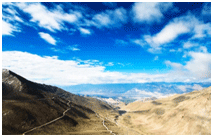
highest motorable pass in the world 5600 Mtrs and has been recorded in the Gunnies Book of World Records. At the top enjoy the nature beauty of snow-capped mountains. In the late afternoon return back to the hotel. Return back to Leh. (Meals: Breakfast, Lunch, Dinner)
Day 5 Leh –Srinagar by flight (Flight duration 1 hour)
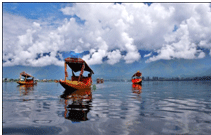
On arrival at the Srinagar airport, you will be received by our representative / driver. Once you board your vehicle, you will proceed to the deluxe houseboat / hotel (as per package selected). Later in the evening proceed for shikara ride in Dal lake. (Meals: Breakfast, Lunch, Dinner)
Day 6 Srinagar – Excursion to Sonmarg (90 kms / 3 hours one way)
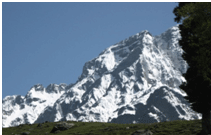
After breakfast, depart for full day excursion to Sonmarg. Sonamarg an alpine valley is situated at the bank of Nallah Sindh, 87 km north-east from Srinagar, it is a popular tourist destination, nestled with in the imposing Himalayan peaks. Enjoy beautiful snow capped peaks and glaciers. Return to Srinagar in the late afternoon. Evening is free for leisure activities. Dinner & overnight on board the houseboat / hotel. (Meals: Breakfast, Lunch, Dinner)
Day 7 Srinagar – Excursion to Gulmarg (90 kms / 2 ½ hours one way)
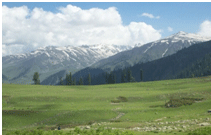
After breakfast, depart for full day excursion to Gulmarg. Gulmarg is a town, a hill station, in Baramula district in the Indian state of Jammu and Kashmir. Enjoy beautiful snow capped peaks and gondola ride (Till 1st level). Later you can take a walk around Gulmarg and enjoy beautiful flowers. Return to Srinagar in the evening. Dinner & overnight on board the houseboat / hotel. (Meals: Breakfast, Lunch, Dinner)
Day 8 Srinagar – Delhi – USA
Srinagar Today after breakfast, check out from your houseboat / hotel and proceed to Srinagar airport for connecting flight to USA.
Social Share
Other Tour packages
News from our blog
- The return of Kashmir December 4, 2014
- Top 10 activities in Kerala, India’s deep south December 4, 2014
- Tamil Nadu to open 25 ecotourism sites December 4, 2014
- Rocky Mountaineer appoints Mazda Travel as General Sales Agent in India December 4, 2014
- Etihad Airways and others to start airlines operations in Kolkata December 4, 2014


